Late Quaternary Relative Sea-Level Changes and Vertical GNSS Motions in the Gulf of Corinth: The Asymmetric Localization of Deformation Inside an Active Half-Graben
Abstract
:1. Introduction

2. Materials and Methods
Geodetic Data
3. Sea-Level Markers
3.1. Tidal Notches
3.2. Marine Terraces
3.3. Beachrocks
3.4. Biological Indicators
3.5. Archaeological Indicators
4. Sea-Level Changes across the Gulf of Corinth
4.1. Southern Gulf of Corinth
Perachora Peninsula
4.2. Northern Gulf of Corinth–Gulf of Alkyonides
5. Discussion
6. Conclusions
Author Contributions
Funding
Data Availability Statement
Acknowledgments
Conflicts of Interest
Appendix A

Appendix B
| Locality | Region | Sea Level Indicator Type | Rate (mm/y) | Reference |
|---|---|---|---|---|
| Aegira | South coast | Biological | +23.28 | [91] |
| Aegira | South coast | Biological | +1.57 | [91] |
| Aegira | South coast | Biological | +1.38 | [91] |
| Akrata | South coast | Geomorphological | +0.62 | [140] |
| Akrata | South coast | Geomorphological | +0.67 | [140] |
| Akrata | South coast | Geomorphological | +0.64 | [140] |
| Akrata | South coast | Geomorphological | +0.63 | [140] |
| Akrata | South coast | Geomorphological | +0.60 | [140] |
| Akrata | South coast | Geomorphological | +0.75 | [140] |
| Akrata | South coast | Geomorphological | +0.82 | [140] |
| Akrata | South coast | Geomorphological | +0.72 | [140] |
| Diakofto | South coast | Geomorphological | +3.12 | [143] |
| Diakofto | South coast | Geomorphological | +2.26 | [143] |
| Diakofto | South coast | Biological | +3.12 | [91] |
| Diakofto | South coast | Biological | +2.40 | [91] |
| Diolkos | South coast | Geomorphological | +0.10 | [129] |
| Diolkos | South coast | Geomorphological | +0.04 | [129] |
| Flampouron | Perachora Peninsula | Geomorphological | +0.29 | [144] |
| Flampouron | Perachora Peninsula | Geomorphological | +0.11 | [144] |
| Flampouron | Perachora Peninsula | Geomorphological | +0.15 | [144] |
| Flampouron | Perachora Peninsula | Geomorphological | +0.36 | [144] |
| Heraeon | Perachora Peninsula | Geomorphological | +0.54 | [144] |
| Heraeon | Perachora Peninsula | Geomorphological | +0.12 | [144] |
| Heraeon | Perachora Peninsula | Geomorphological | +0.46 | [29] |
| Heraeon | Perachora Peninsula | Geomorphological | +0.46 | [29] |
| Heraeon | Perachora Peninsula | Geomorphological | +0.46 | [29] |
| Heraeon | Perachora Peninsula | Geomorphological | +0.46 | [29] |
| Heraeon | Perachora Peninsula | Geomorphological | +0.46 | [29] |
| Heraeon | Perachora Peninsula | Geomorphological | +0.55 | [29] |
| Heraeon | Perachora Peninsula | Geomorphological | +0.42 | [29] |
| Heraeon | Perachora Peninsula | Geomorphological | +0.55 | [29] |
| Heraeon | Perachora Peninsula | Geomorphological | +0.55 | [29] |
| Heraeon | Perachora Peninsula | Geomorphological | +0.46 | [29] |
| Heraeon | Perachora Peninsula | Geomorphological | +0.80 | [145] |
| Heraeon | Perachora Peninsula | Geomorphological | +0.25–0.52 | [39] |
| Heraeon | Perachora Peninsula | Geomorphological | +0.49 | [55] |
| Heraeon | Perachora Peninsula | Geomorphological | +0.57 | [55] |
| Heraeon | Perachora Peninsula | Geomorphological | +0.39 | [55] |
| Heraeon | Perachora Peninsula | Geomorphological | +0.38 | [55] |
| Heraeon | Perachora Peninsula | Geomorphological | +0.26 | [55] |
| Heraion | Perachora Peninsula | Geomorphological | +0.55 | [97] |
| Heraion | Perachora Peninsula | Geomorphological | +0.68 | [97] |
| Heraion | Perachora Peninsula | Geomorphological | +0.90 | [97] |
| Lambiri | South coast | Geomorphological | +1.60 | [146] |
| Lechaion | South coast | Biological | +0.68 | [147] |
| Lechaion | South coast | Biological | +0.38 | [148] |
| Lechaion | South coast | Biological | +0.42 | [148] |
| Lechaion | South coast | Biological | +0.36 | [148] |
| Lechaion | South coast | Biological | +0.41 | [148] |
| Mavra Litharia | South coast | Biological | +1.28 | [47] |
| Mavra Litharia | South coast | Biological | +1.47 | [47] |
| Mavra Litharia | South coast | Biological | +1.47 | [131] |
| Mavra Litharia | South coast | Biological | +1.37 | [149] |
| Mylokopi | Perachora Peninsula | Geomorphological | +0.77 | [97] |
| Mylokopi | Perachora Peninsula | Geomorphological | +0.73 | [97] |
| Platanos beach | South coast | Biological | +1.08 | [91] |
| Platanos beach | South coast | Biological | +2.18 | [91] |
| Platanos beach | South coast | Biological | +1.75 | [91] |
| Platanos beach | South coast | Biological | +2.32 | [91] |
| Platanos beach | South coast | Biological | +1.26 | [91] |
| Platanos beach | South coast | Biological | +0.44 | [149] |
| Psatha | Alkyonides Gulf | Geomorphological | +0.29 | [150] |
| Psatha | Alkyonides Gulf | Geomorphological | +0.23 | [150] |
| Psathopirgos | South coast | Geomorphological | +0.70 | [46] |
| Vouliagmeni | Perachora Peninsula | Biological | +0.84 | [139] |
| Vouliagmeni | Perachora Peninsula | Biological | +0.61 | [139] |
| Vouliagmeni | Perachora Peninsula | Biological | +0.79 | [139] |
References
- Azor, A.; Keller, E.A.; Yeats, R.S. Geomorphic Indicators of Active Fold Growth: South Mountain-Oak Ridge Anticline, Ventura Basin, Southern California. Bull. Geol. Soc. Am. 2002, 114, 745–753. [Google Scholar] [CrossRef]
- King, G.; Sturdy, D.; Whitney, J. The Landscape Geometry and Active Tectonics of Northwest Greece. Geol. Soc. Am. Bull. 1993, 105, 137–161. [Google Scholar] [CrossRef]
- Burbank, D.W.; Anderson, R.S. Tectonic Geomorphology. Dep. Geosci. Pa. State Univ. 2001, 140, 284–291. [Google Scholar]
- Doutsos, T.; Piper, D.J.W. Listric Faulting, Sedimentation, and Morphological Evolution of the Quaternary Eastern Corinth Rift, Greece: First Stages of Continental Rifting. Bull. Geol. Soc. Am. 1990, 102, 812–829. [Google Scholar] [CrossRef]
- Moretti, I.; Sakellariou, D.; Lykousis, V.; Micarelli, L. The Gulf of Corinth: An Active Half Graben? J. Geodyn. 2003, 36, 323–340. [Google Scholar] [CrossRef]
- Gaki-papanastassiou, K.; Papanastassiou, D.; Maroukian, H. Recent Uplift Rates at Perachora Peninsula, East Gulf of Corinth, Greece, Based on Geomorphological—Archaeological Evidence and Radiocarbon Dates. Hell. J. Geosci. 2007, 42, 45–56. [Google Scholar]
- Charalampakis, M.; Lykousis, V.; Sakellariou, D.; Papatheodorou, G.; Ferentinos, G. The Tectono-Sedimentary Evolution of the Lechaion Gulf, the South Eastern Branch of the Corinth Graben, Greece. Mar. Geol. 2014, 351, 58–75. [Google Scholar] [CrossRef]
- Mesimeri, M.; Ganas, A.; Pankow, K.L. Multisegment Ruptures and Vp/Vs Variations during the 2020–2021 Seismic Crisis in Western Corinth Gulf, Greece. Geophys. J. Int. 2022, 230, 334–348. [Google Scholar] [CrossRef]
- Ganas, A.; Chousianitis, K.; Batsi, E.; Kolligri, M.; Agalos, A.; Chouliaras, G.; Makropoulos, K. The January 2010 Efpalion Earthquakes (Gulf of Corinth, Central Greece): Earthquake Interactions and Blind Normal Faulting. J. Seism. 2013, 17, 465–484. [Google Scholar] [CrossRef]
- Taylor, B.; Weiss, J.R.; Goodliffe, A.M.; Sachpazi, M.; Laigle, M.; Hirn, A. The Structures, Stratigraphy and Evolution of the Gulf of Corinth Rift, Greece. Geophys. J. Int. 2011, 185, 1189–1219. [Google Scholar] [CrossRef]
- Brooks, M.; Ferentinos, G. Tectonics and Sedimentation in the Gulf of Corinth and the Zakynthos and Kefallinia Channels, Western Greece. Tectonophysics 1984, 101, 25–54. [Google Scholar] [CrossRef]
- McKenzie, D. Active Tectonics of the Alpine-Himalayan Belt: The Aegean Sea and Surrounding Regions. Geophys. J. R. Astron. Soc. 1978, 55, 217–254. [Google Scholar] [CrossRef]
- Jackson, J.; Gagnepain, G.; Houseman, G.; King, G.C.P.; Papadimitriou, P.; Soufleris, C.; Virieux, J. Seismicity, Normal Faulting, and the Geomorphological Development of the Gulf of Corinth (Greece): The Corinth Earthquakes of February and March 1981. Earth Planet. Sci. Lett. 1982, 57, 377–397. [Google Scholar] [CrossRef]
- Tselentis, G.A.; Makropoulos, K.C. Rates of Crustal Deformation in the Gulf of Corinth (Central Greece) as Determined from Seismicity. Tectonophysics 1986, 124, 55–66. [Google Scholar] [CrossRef]
- Armijo, R.; Meyer, B.; King, G.C.P.; Rigo, A.; Papanastassiou, D. Quaternary Evolution of the Corinth Rift and Its Implications for the Late Cenozoic Evolution of the Aegean. Geophys. J. Int. 1996, 126, 11–53. [Google Scholar] [CrossRef]
- Clarke, P.J.; Davies, R.R.; England, P.C.; Parsons, B.E.; Billiris, H.; Paradissis, D.; Veis, G.; Denys, P.H.; Cross, P.A.; Ashkenazi, V.; et al. Geodetic Estimate of Seismic Hazard in the Gulf of Korinthos. Geophys. Res. Lett. 1997, 24, 1303–1306. [Google Scholar] [CrossRef]
- Clarke, P.J.; Davies, R.R.; England, P.C.; Parsons, B.; Billiris, H.; Paradissis, D.; Veis, G.; Cross, P.A.; Denys, P.H.; Ashkenazi, V.; et al. Crustal Strain in Greece from Repeated GPS Measurements in the Interval 1989-1997. Geophys. J. Int. 1998, 135, 195–214. [Google Scholar] [CrossRef]
- Briole, P.; Rigo, A.; Lyon-Caen, H.; Ruegg, J.C.; Papazissi, K.; Mitsakaki, C.; Balodimou, A.; Veis, G.; Hatzfeld, D.; Deschamps, A. Active Deformation of the Corinth Rift, Greece: Results from Repeated Global Positioning System Surveys between 1990 and 1995. J. Geophys. Res. 2000, 105, 25605–25625. [Google Scholar] [CrossRef]
- Briole, P.; Ganas, A.; Elias, P.; Dimitrov, D. The GPS Velocity Field of the Aegean. New Observations, Contribution of the Earthquakes, Crustal Blocks Model. Geophys. J. Int. 2021, 226, 468–492. [Google Scholar] [CrossRef]
- McNeill, L.C.; Shillington, D.J.; Carter, G.D.O.; Everest, J.D.; Gawthorpe, R.L.; Miller, C.; Phillips, M.P.; Collier, R.E.L.; Cvetkoska, A.; De Gelder, G.; et al. High-Resolution Record Reveals Climate-Driven Environmental and Sedimentary Changes in an Active Rift. Sci. Rep. 2019, 9, 3116. [Google Scholar] [CrossRef]
- Avallone, A.; Briole, P.; Agatza-Balodimou, A.M.; Billiris, H.; Charade, O.; Mitsakaki, C.; Nercessian, A.; Papazissi, K.; Paradissis, D.; Veis, G. Analyse de Onze Années de Mesures de Deformations Collectées Par GPS Dans La Zone Du Laboratoire Du Rift de Corinthe. Comptes Rendus Geosci. 2004, 336, 301–311. [Google Scholar] [CrossRef]
- Davies, R.; England, P.; Parsons, B.; Billiris, H.; Paradissis, D.; Veis, G. Geodetic Strain of Greece in the Interval 1892–1992. Distribution 1997, 102, 24571–24588. [Google Scholar] [CrossRef]
- Roberts, S.; Jackson, J. Active Normal Fault in Central Greece: An Overview. In The Geometry of Normal Faults; Special Publications; Roberts, A.M., Yielding, G., Freeman, B., Eds.; Geological Society of London: London, UK, 1991; Volume 56, pp. 125–142. [Google Scholar]
- Roberts, G.P. Noncharacteristic Normal Faulting Surface Ruptures from the Gulf of Corinth, Greece. J. Geophys. Res. 1996, 101, 25255–25267. [Google Scholar] [CrossRef]
- Roberts, G.P. Variation in Fault-Slip Directions along Active and Segmented Normal Fault Systems. J. Struct. Geol. 1996, 18, 835–845. [Google Scholar] [CrossRef]
- Roberts, G.P.; Koukouvelas, I. Structural and Seismological Segmentation of the Gulf of Corinth Fault System: Implications for Models of Fault Growth. Ann. Geophy. 1996, 39, 619–646. [Google Scholar] [CrossRef]
- Koukouvelas, I.K.; Asimakopoulos, M.; Doutsos, T.T. Fractal Characteristics of Active Normal Faults: An Example of the Eastern Gulf of Corinth, Greece. Tectonophysics 1999, 308, 263–274. [Google Scholar] [CrossRef]
- Micarelli, L.; Moretti, I.; Daniel, J.M. Structural Properties of Rift-Related Normal Faults: The Case Study of the Gulf of Corinth, Greece. J. Geodyn. 2003, 36, 275–303. [Google Scholar] [CrossRef]
- Morewood, N.C.; Roberts, G.P. Lateral Propagation of the Surface Trace of the South Alkyonides Normal Fault Segment, Central Greece: Its Impact on Models of Fault Growth and Displacement-Length Relationships. J. Struct. Geol. 1999, 21, 635–652. [Google Scholar] [CrossRef]
- Morewood, N.C.; Roberts, G.P. Geometry, Kinematics and Rates of Deformation in a Normal Fault Segment Boundary, Central Greece. Geophys. Res. Lett. 1997, 24, 3081–3084. [Google Scholar] [CrossRef]
- Pavlides, S.B.; Koukouvelas, I.K.; Kokkalas, S.; Stamatopoulos, L.; Keramydas, D.; Tsodoulos, I. Late Holocene Evolution of the East Eliki Fault, Gulf of Corinth (Central Greece). Quat. Int. 2004, 115–116, 139–154. [Google Scholar] [CrossRef]
- Koukouvelas, I.K.; Doutsos, T.T. Implications of Structural Segmentation during Earthquakes: The 1995 Egion Earthquake, Gulf of Corinth, Greece. J. Struct. Geol. 1996, 18, 1381–1388. [Google Scholar] [CrossRef]
- Ori, G.G. Geologic History of the Extensional Basin of the Gulf of Corinth (?Miocene-Pleistocene), Greece. Geology 1989, 17, 918–921. [Google Scholar] [CrossRef]
- Doutsos, T.; Poulimenos, G. Geometry and Kinematics of Active Faults and Their Seismotectonic Significance in the Western Corinth-Patras Rift (Greece). J. Struct. Geol. 1992, 14, 689–699. [Google Scholar] [CrossRef]
- Sorel, D. A Pleistocene and Still-Active Detachment Fault and the Origin of the Corinth-Patras Rift, Greece. Geology 2000, 28, 83–86. [Google Scholar] [CrossRef]
- Goldsworthy, M.; Jackson, J. Migration of Activity within Normal Fault Systems: Examples from the Quaternary of Mainland Greece. J. Struct. Geol. 2001, 23, 489–506. [Google Scholar] [CrossRef]
- Rohais, S.; Joannin, S.; Colin, J.P.; Suc, J.P.; Guillocheau, F.; Eschard, R. Age and Environmental Evolution of the Syn-Rift Fill of the Southern Coast of the Gulf of Corinth (Akrata-Derveni Region, Greece). BSGF Earth Sci. Bull. 2007, 178, 231–243. [Google Scholar] [CrossRef]
- Rohais, S.; Eschard, R.; Ford, M.; Guillocheau, F.; Moretti, I. Stratigraphic Architecture of the Plio-Pleistocene Infill of the Corinth Rift: Implications for Its Structural Evolution. Tectonophysics 2007, 440, 5–28. [Google Scholar] [CrossRef]
- Roberts, G.P.; Houghton, S.L.; Underwood, C.; Papanikolaou, I.; Cowie, P.A.; Van Calsteren, P.; Wigley, T.; Cooper, F.J.; McArthur, J.M. Localization of Quaternary Slip Rates in an Active Rift in 105 Years: An Example from Central Greece Constrained by 234U–230Th Coral Dates from Uplifted Paleoshorelines. J. Geophys. Res. 2009, 114, B10406. [Google Scholar] [CrossRef]
- Jolivet, L.; Brun, J.P.; Gautier, P.; Lallemant, S.; Patriat, M. 3D-Kinematics of Extension in the Aegean Region from the Early Miocene to the Present, Insights from the Ductile Crust. Bull. Soc. Geol. Fr. 1994, 165, 195–209. [Google Scholar]
- Doutsos, T.; Kontopoulos, N.; Poulimenos, G. The Corinth-Patras Rift as the Initial Stage of Continental Fragmentation behind an Active Island Arc (Greece). Basin Res. 1988, 1, 177–190. [Google Scholar] [CrossRef]
- Jolivet, L. A Comparison of Geodetic and Finite Strain Pattern in the Aegean, Geodynamic Implications. Earth Planet. Sci. Lett. 2001, 187, 95–104. [Google Scholar] [CrossRef]
- Sachpazi, M.; Galvé, A.; Laigle, M.; Hirn, A.; Sokos, E.; Serpetsidaki, A.; Marthelot, J.M.; Pi Alperin, J.M.; Zelt, B.; Taylor, B. Moho Topography under Central Greece and Its Compensation by Pn Time-Terms for the Accurate Location of Hypocenters: The Example of the Gulf of Corinth 1995 Aigion Earthquake. Tectonophysics 2007, 440, 53–65. [Google Scholar] [CrossRef]
- Bernard, P.; Briole, P.; Meyer, B.; Lyon-Caen, H.; Gomez, J.M.; Tiberi, C.; Berge, C.; Cattin, R.; Hatzfeld, D.; Lachet, C.; et al. The Ms = 6.2, June 15, 1995 Aigion Earthquake (Greece): Evidence for Low Angle Normal Faulting in the Corinth Rift. J. Seismol. 1997, 1, 131–150. [Google Scholar] [CrossRef]
- Palyvos, N.; Sorel, D.; Lemeille, F.; Mancini, M.; Pantosti, D.; Julia, R.; Triantaphyllou, M.; De Martini, P.M. Review and New Data on Uplift Rates at the W Termination of the Corinth Rift and the Ne Rion Graben Area (Achaia, NW Peloponnesos). Bull. Geol. Soc. Greece 2007, 40, 412–424. [Google Scholar] [CrossRef]
- Houghton, S.L.; Roberts, G.P.; Papanikolaou, I.D.; Mcarthur, J.M.; Gilmour, M.A. New 234 U–230 Th Coral Dates from the Western Gulf of Corinth: Implications for Extensional Tectonics. Geophys. Res. Lett. 2003, 30, 13/1–13/4. [Google Scholar] [CrossRef]
- Pirazzoli, P.A.; Stiros, S.C.; Fontugne, M.; Arnold, M. Holocene and Quaternary Uplift in the Central Part of the Southern Coast of the Corinth Gulf (Greece). Mar. Geol. 2004, 212, 35–44. [Google Scholar] [CrossRef]
- Zelilidis, A. Drainage Evolution in a Rifted Basin, Corinth Graben, Greece. Geomorphology 2000, 35, 69–85. [Google Scholar] [CrossRef]
- Doutsos, T.; Kontopoulos, N.; Frydas, D. Neotectonic Evolution of Northwestern-Continental Greece. Geol. Rundsch. 1987, 76, 433–450. [Google Scholar] [CrossRef]
- Zelilidis, A.; Koukouvelas, I.; Doutsos, T. Neogene Paleostress Changes behind the Forearc Fold Belt in the Patraikos Gulf Area, Western Greece. Neues Jahrb. Für Geol. Und Paläontologie-Monatshefte 1988, 5, 311–325. [Google Scholar] [CrossRef]
- Ferentinos, G.; Brooks, M.; Doutsos, T. Quaternary Tectonics in the Gulf of Patras, Western Greece. J. Struct. Geol. 1985, 7, 713–717. [Google Scholar] [CrossRef]
- Papadopoulos, G.A.; Vassilopoulou, A.; Plessa, A. A New Catalogue of Historical Earthquakes in the Corinth Rift, Central Greece: 480 BC–AD 1910. In Historical Earthquakes and Tsunamis in the Corinth Rift, Central Greece; National Observatory of Athens: Athens, Greece, 2000. [Google Scholar]
- Burton, P.W.; Qin, C.; Tselentis, G. Extreme Earthquake and Earthquake Perceptibility Study in Greece and Its Surrounding Area. Nat. Hazards 2004, 32, 277–312. [Google Scholar] [CrossRef]
- Pavlides, S.; Caputo, R.; Koukouvelas, I.; Kokkalas, S.; Chatzipetros, A. Paleoseismological Investigations of Aegean-Type Active Faults in Mainland Greece and Their Implications. In Post-Collisional Tectonics and Magmatism in the Mediterranean Region and Asia; Special Paper; Dilek, Y., Pavlides, S., Eds.; Geological Society of America: Boulder, Colorado, USA, 2006; Volume 409, pp. 175–188. [Google Scholar]
- Robertson, J.; Roberts, G.P.; Iezzi, F.; Meschis, M.; Gheorghiu, D.M.; Sahy, D.; Bristow, C.; Sgambato, C. Distributed Normal Faulting in the Tip Zone of the South Alkyonides Fault System, Gulf of Corinth, Constrained Using 36Cl Exposure Dating of Late-Quaternary Wave-Cut Platforms. J. Struct. Geol. 2020, 136, 104063. [Google Scholar] [CrossRef]
- Vita-Finzi, C.; King, G.C.P. The Seismicity, Geomorphology and Structural Evolution of the Corinth Area of Greece. Philos. Trans. R. Soc. London, Ser. A 1985, 314, 379–407. [Google Scholar]
- Evelpidou, N.; Karkani, A.; Tzouxanioti, M.; Spyrou, E.; Petropoulos, A.; Lakidi, L. Inventory and Assessment of the Geomorphosites in Central Cyclades, Greece: The Case of Paros and Naxos Islands. Geosciences 2021, 11, 512. [Google Scholar] [CrossRef]
- Evelpidou, N.; Karkani, A.; Spyrou, E.; Gavalas, A.-T. Assessing and Promoting the Coastal Geomorphological Heritage of the Eastern Coast of Rhodes Island, Southeastern Aegean, Greece. Sci. Cult. 2023, 9, 13–43. [Google Scholar]
- D’Agostino, N.; Métois, M.; Koci, R.; Duni, L.; Kuka, N.; Ganas, A.; Georgiev, I.; Jouanne, F.; Kaludjerovic, N.; Kandić, R. Active Crustal Deformation and Rotations in the Southwestern Balkans from Continuous GPS Measurements. Earth Planet. Sci. Lett. 2020, 539, 116246. [Google Scholar] [CrossRef]
- Serpelloni, E.; Cavaliere, A.; Martelli, L.; Pintori, F.; Anderlini, L.; Borghi, A.; Randazzo, D.; Bruni, S.; Devoti, R.; Perfetti, P.; et al. Surface Velocities and Strain-Rates in the Euro-Mediterranean Region From Massive GPS Data Processing. Front. Earth Sci. 2022, 10, 907897. [Google Scholar] [CrossRef]
- Altamimi, Z.; Rebischung, P.; Métivier, L.; Collilieux, X. ITRF2014: A New Release of the International Terrestrial Reference Frame Modeling Nonlinear Station Motions. J. Geophys. Res. Solid Earth 2016, 121, 6109–6131. [Google Scholar] [CrossRef]
- Serpetsidaki, A.; Elias, P.; Ilieva, M.; Bernard, P.; Briole, P.; Deschamps, A.; Lambotte, S.; Lyon-Caen, H.; Sokos, E.; Tselentis, G.A. New Constraints from Seismology and Geodesy on the Mw = 6.4 2008 Movri (Greece) Earthquake: Evidence for a Growing Strike-Slip Fault System. Geophys. J. Int. 2014, 198, 1373–1386. [Google Scholar] [CrossRef]
- Ganas, A.; Serpelloni, E.; Drakatos, G.; Kolligri, M.; Adamis, I.; Tsimi, C.; Batsi, E. The Mw 6.4 SW-Achaia (Western Greece) Earthquake of 8 June 2008: Seismological, Field, GPS Observations, and Stress Modeling. J. Earthq. Eng. 2009, 13, 1101–1124. [Google Scholar] [CrossRef]
- Sokos, E.; Zahradník, J.; Kiratzi, A.; Janský, J.; Gallovič, F.; Novotny, O.; Kostelecký, J.; Serpetsidaki, A.; Tselentis, G.A. The January 2010 Efpalio Earthquake Sequence in the Western Corinth Gulf (Greece). Tectonophysics 2012, 530–531, 299–309. [Google Scholar] [CrossRef]
- Ganas, A.; Briole, P.; Bozionelos, G.; Barberopoulou, A.; Elias, P.; Tsironi, V.; Valkaniotis, S.; Moshou, A.; Mintourakis, I. The 25 October 2018 Mw = 6.7 Zakynthos Earthquake (Ionian Sea, Greece): A Low-Angle Fault Model Based on GNSS Data, Relocated Seismicity, Small Tsunami and Implications for the Seismic Hazard in the West Hellenic Arc. J. Geodyn. 2020, 137, 101731. [Google Scholar] [CrossRef]
- Cirella, A.; Romano, F.; Avallone, A.; Piatanesi, A.; Briole, P.; Ganas, A.; Theodoulidis, N.; Chousianitis, K.; Volpe, M.; Bozionellos, G.; et al. The 2018 Mw 6.8 Zakynthos (Ionian Sea, Greece) Earthquake: Seismic Source and Local Tsunami Characterization. Geophys. J. Int. 2020, 221, 1043–1054. [Google Scholar] [CrossRef]
- Kaviris, G.; Elias, P.; Kapetanidis, V.; Serpetsidaki, A.; Karakonstantis, A.; Plicka, V.; De Barros, L.; Sokos, E.; Kassaras, I.; Sakkas, V.; et al. The Western Gulf of Corinth (Greece) 2020–2021 Seismic Crisis and Cascading Events: First Results from the Corinth Rift Laboratory Network. Seism. Rec. 2021, 1, 85–95. [Google Scholar] [CrossRef]
- Biggs, J.; Wright, T.J. How Satellite InSAR Has Grown from Opportunistic Science to Routine Monitoring over the Last Decade. Nat. Commun. 2020, 11, 3863. [Google Scholar] [CrossRef] [PubMed]
- Elias, P.; Briole, P. Ground Deformations in the Corinth Rift, Greece, Investigated Through the Means of SAR Multitemporal Interferometry. Geochem. Geophys. Geosystems 2018, 19, 4836–4857. [Google Scholar] [CrossRef]
- Melgar, D.; Ganas, A.; Taymaz, T.; Valkaniotis, S.; Crowell, B.W.; Kapetanidis, V.; Tsironi, V.; Yolsal-Çevikbilen, S.; Öcalan, T. Rupture Kinematics of 2020 January 24 Mw 6.7 Doǧanyol-Sivrice, Turkey Earthquake on the East Anatolian Fault Zone Imaged by Space Geodesy. Geophys. J. Int. 2020, 223, 862–874. [Google Scholar] [CrossRef]
- Crosetto, M.; Solari, L.; Balasis-Levinsen, J.; Bateson, L.; Casagli, N.; Frei, M.; Oyen, A.; Moldestad, D.A.; Mróz, M. Deformation Monitoring at European Scale: The Copernicus Ground Motion Service. Int. Arch. Photogramm. Remote Sens. Spat. Inf. Sci. 2021, 43, 141–146. [Google Scholar] [CrossRef]
- Costantini, M.; Minati, F.; Trillo, F.; Ferretti, A.; Passera, E.; Rucci, A.; Dehls, J.; Larsen, Y.; Marinkovic, P.; Eineder, M.; et al. EGMS: A New Copernicus Service for Ground Motion Mapping and Monitoring. In Proceedings of the EGU General Assembly 2022, Vienna, Austria, 23–27 May 2022; p. EGU22-9733. [Google Scholar]
- Copernicus European Ground Motion Service. Available online: https://egms.land.copernicus.eu/ (accessed on 2 July 2023).
- Miller, K.G.; Kominz, A.; Browning, J.V.; Wright, J.D.; Mountain, G.S.; Katz, M.E.; Sugarman, P.J.; Cramer, B.S.; Christie-Blick, N.; Pekar, S.F. The Phanerozoic Record of Global Sea-Level Change. Science 2005, 310, 1293–1298. [Google Scholar] [CrossRef]
- Gornitz, V. Eustasy. In Encyclopedia of Coastal Science; Schwartz, M., Ed.; Springer: Dordrecht, The Netherlands, 2005; pp. 439–442. [Google Scholar]
- Kemp, A.C.; Dutton, A.; Raymo, M.E. Paleo Constraints on Future Sea-Level Rise. Curr. Clim. Chang. Rep. 2015, 1, 205–215. [Google Scholar] [CrossRef]
- Ferentinos, G.; Papatheodorou, G.; Collins, M.B. Sediment Transport Processes on an Active Submarine Fault Escarpment: Gulf of Corinth, Greece. Mar. Geol. 1988, 83, 43–61. [Google Scholar] [CrossRef]
- Jackson, J.; Mckenzie, D. The Relationship between Plate Motions and Seismic Moment Tensors, and the Rates of Active Deformation in the Mediterranean and Middle East. Geophys. J. 1988, 93, 45–73. [Google Scholar] [CrossRef]
- Sakellariou, D.; Likousis, B.; Rousakis, I.; Georgiou, P. Sliding Phenomena on Active Fault Slopes: Panagopoula Site. Bull. Geol. Soc. Greece 2001, 34, 1723–1731. [Google Scholar]
- Pirazzoli, P.A. Marine Notches. In Sea-Level Research; Plassche, O., Ed.; Springer: Dordrecht, The Netherlands, 1986; pp. 361–400. [Google Scholar]
- Antonioli, F.; Lo Presti, V.; Rovere, A.; Ferranti, L.; Anzidei, M.; Furlani, S.; Mastronuzzi, G.; Orru, P.E.; Scicchitano, G.; Sannino, G.; et al. Tidal Notches in Mediterranean Sea: A Comprehensive Analysis. Quat. Sci. Rev. 2015, 119, 66–84. [Google Scholar] [CrossRef]
- Evelpidou, N.; Kampolis, I.; Pirazzoli, P.A.; Vassilopoulos, A. Global Sea-Level Rise and the Disappearance of Tidal Notches. Glob. Planet. Change 2012, 92–93, 248–256. [Google Scholar] [CrossRef]
- Laborel, J.; Laborel-Deguen, F. Sea-Level Indicators, Biologic. In Encyclopedia of Coastal Science; Schwartz, M., Ed.; Springer: Dordrecht, The Netherlands, 2005; pp. 833–834. [Google Scholar]
- Furlani, S.; Biolchi, S.; Cucchi, F.; Antonioli, F.; Busetti, M.; Melis, R. Tectonic Effects on Late Holocene Sea Level Changes in the Gulf of Trieste (NE Adriatic Sea, Italy). Quat. Int. 2011, 232, 144–157. [Google Scholar] [CrossRef]
- Furlani, S.; Cucchi, F.; Biolchi, S.; Odorico, R. Notches in the Northern Adriatic Sea: Genesis and Development. Quat. Int. 2011, 232, 158–168. [Google Scholar] [CrossRef]
- Evelpidou, N.; Pirazzoli, P.A.; Vassilopoulos, A.; Tomasin, A. Holocene Submerged Shorelines on Theologos Area (Greece). Z. Für Geomorphol. 2011, 55, 31–44. [Google Scholar] [CrossRef]
- Evelpidou, N.; Pirazzoli, P.A. Holocene Relative Sea-Level Changes from Submerged Tidal Notches: A Methodological Approach. Quaternaire 2014, 25, 313–320. [Google Scholar] [CrossRef]
- Pirazzoli, P.A.; Evelpidou, N. Tidal Notches: A Sea-Level Indicator of Uncertain Archival Trustworthiness. Palaeogeogr. Palaeoclim. Palaeoecol. 2013, 369, 377–384. [Google Scholar] [CrossRef]
- Trenhaile, A.S. Coastal Notches: Their Morphology, Formation, and Function. Earth Sci. Rev. 2015, 150, 285–304. [Google Scholar] [CrossRef]
- Pirazzoli, P.A. A Review of Possible Eustatic, Isostatic and Tectonic Contributions in Eight Late-Holocene Relative Sea-Level Histories from the Mediterranean Area. Quat. Sci. Rev. 2005, 24, 1989–2001. [Google Scholar] [CrossRef]
- Stewart, I.; Vita-Finzi, C. Coastal Uplift on Active Normal Faults: The Eliki Fault, Greece. Geophys. Res. Lett. 1996, 23, 1853–1856. [Google Scholar] [CrossRef]
- Cooper, F.J.; Roberts, G.P.; Underwood, C.J. A Comparison of 103–105 Year Uplift Rates on the South Alkyonides Fault, Central Greece: Holocene Climate Stability and the Formation of Coastal Notches. Geophys. Res. Lett. 2007, 34, L14310. [Google Scholar] [CrossRef]
- Boulton, S.J.; Stewart, I.S. Holocene Coastal Notches in the Mediterranean Region: Indicators of Palaeoseismic Clustering? Geomorphology 2015, 237, 29–37. [Google Scholar] [CrossRef]
- Pirazzoli, P.A. World Atlas of Holocene Sea-Level Changes; Elsevier Oceanography Series; Elsevier Science: Amsterdam, The Netherlands; New York, NY, USA, 1991. [Google Scholar]
- Pirazzoli, P.A.; Thommeret, J.; Thommeret, Y.; Laborel, J.; Montaggioni, L.F. Crustal Block Movements from Holocene Shorelines: Crete and Antikythira (Greece). Tectonophysics 1982, 86, 27–43. [Google Scholar] [CrossRef]
- Pirazzoli, P.A.; Montaggioni, L.; Saliège, J.F.; Segonzac, G.; Thommeret, Y.; Vergnaud-Grazzini, C. Crustal Block Movements from Holocene Shorelines: Rhodes Island (Greece) Related Papers Crust Al Block Movement s from Holocene Shorelines: Cret e and Ant Ikyt Hira (Greece LUCIEN MONTAGGIONI Lat e Holocene Relat Ive Sea-Level Changes in Lebanon, East Ern. Tectonophysics 1989, 170, 89–114. [Google Scholar] [CrossRef]
- Pirazzoli, P.A.; Stiros, S.C.; Arnold, M.; Laborel, J.; Laborel-Deguen, F.; Papageorgiou, S. Episodic Uplift Deduced from Holocene Shorelines in the Perachora Peninsula, Corinth Area, Greece. Tectonophysics 1994, 229, 201–209. [Google Scholar] [CrossRef]
- Liew, P.M.; Pirazzoli, P.A.; Hsieh, M.L.; Arnold, M.; Barusseau, J.P.; Fontugne, M.; Giresse, P. Holocene Tectonic Uplift Deduced from Elevated Shorelines, Eastern Coastal Range of Taiwan. Tectonophysics 1993, 222, 55–68. [Google Scholar] [CrossRef]
- Hantoro, W.S.; Pirazzoli, P.A.; Jouaunic, C.; Faure, H.; Hoang, C.T.; Radtke, U.; Causse, C.; Best, M.B.; Lafont, R.; Bieda, S.; et al. Quaternary Uplifted Coral Reef Terraces on Alor Island, East Indonesia. Coral Reefs 1994, 13, 215–223. [Google Scholar] [CrossRef]
- Bard, E.; Jouannic, C.; Hamelin, B.; Pirazzoli, P.; Arnold, M.; Faure, G.; Sumosusastro, P. Syaefudin Pleistocene Sea Levels and Tectonic Uplift Based on Dating of Corals from Sumba Island, Indonesia. Geophys. Res. Lett. 1996, 23, 1473–1476. [Google Scholar] [CrossRef]
- Stewart, I.S.; Cundy, A.; Kershaw, S.; Firth, C. Holocene Coastal Uplift in the Taormina Area, Northeastern Sicily: Implications for the Southern Prolongation of the Calabrian Seismogenic Belt. J. Geodyn. 1997, 24, 37–50. [Google Scholar] [CrossRef]
- Stiros, S.C.; Laborel, J.; Laborel-Deguen, F.; Papageorgiou, S.; Evin, J.; Pirazzoli, P.A. Seismic Coastal Uplift in a Region of Subsidence: Holocene Raised Shorelines of Samos Island, Aegean Sea, Greece. Mar. Geol. 2000, 170, 41–58. [Google Scholar] [CrossRef]
- Stiros, S.C.; Pirazzoli, P.A.; Fontugne, M. New Evidence of Holocene Coastal Uplift in the Strophades Islets (W Hellenic Arc, Greece). Mar. Geol. 2009, 267, 207–211. [Google Scholar] [CrossRef]
- Morhange, C.; Pirazzoli, P.A.; Marriner, N.; Montaggioni, L.F.; Nammour, T. Late Holocene Relative Sea-Level Changes in Lebanon, Eastern Mediterranean. Mar. Geol. 2006, 230, 99–114. [Google Scholar] [CrossRef]
- Faivre, S.; Butorac, V. Recently Submerged Tidal Notches in the Wider Makarska Area (Central Adriatic, Croatia). Quat. Int. 2018, 494, 225–235. [Google Scholar] [CrossRef]
- Chappell, J. Geology of Coral Terraces, Huon Peninsula, New Guinea: A Study of Quaternary Tectonic Movements and Sea-Level Changes. Bull. Geol. Soc. Am. 1974, 85, 553. [Google Scholar] [CrossRef]
- Valensise, G.; Ward, S.N. Long-Term Uplift of the Santa Cruz Coastline in Response to Repeated Earthquakes along the San Andreas Fault. Bull. Seismol. Soc. Am. 1991, 81, 1694–1704. [Google Scholar]
- Rosenbloom, N.A.; Anderson, R.S. Hillslope and Channel Evolution in a Marine Terraced Landscape, Santa Cruz, California Abstract. A Flight of Marine Terraces along California Coastline Provides a Unique Posits m Tall Decaying Sea Become Rounded of the Five Bedrock Sueam Channels to Th. J. Geophys. Res. 1994, 99, 14013–14029. [Google Scholar] [CrossRef]
- Robertson, J.; Meschis, M.; Roberts, G.P.; Ganas, A.; Gheorghiu, D.M. Temporally Constant Quaternary Uplift Rates and Their Relationship with Extensional Upper-Plate Faults in South Crete (Greece), Constrained with 36Cl Cosmogenic Exposure Dating. Tectonics 2019, 38, 1189–1222. [Google Scholar] [CrossRef]
- Limber, P.W.; Murray, A.B. Beach and Sea-Cliff Dynamics as a Driver of Long-Term Rocky Coastline Evolution and Stability. Geology 2011, 39, 1147–1150. [Google Scholar] [CrossRef]
- Saillard, M.; Hall, S.R.; Audin, L.; Farber, D.L.; Hérail, G.; Martinod, J.; Regard, V.; Finkel, R.C.; Bondoux, F. Non-Steady Long-Term Uplift Rates and Pleistocene Marine Terrace Development along the Andean Margin of Chile (31° S) Inferred from 10Be Dating. Earth Planet. Sci. Lett. 2009, 277, 50–63. [Google Scholar] [CrossRef]
- Marquardt, C.; Lavenu, A.; Ortlieb, L.; Godoy, E.; Comte, D. Coastal Neotectonics in Southern Central Andes: Uplift and Deformation of Marine Terraces in Northern Chile (27° S). Tectonophysics 2004, 394, 193–219. [Google Scholar] [CrossRef]
- Trenhaile, A.S. Modeling the Development of Marine Terraces on Tectonically Mobile Rock Coasts. Mar. Geol. 2002, 185, 341–361. [Google Scholar] [CrossRef]
- Muhs, D.R.; Rockwell, T.K.; Kennedy, G.L. Late Quaternary Uplift Rates of Marine Terraces on the Pacific Coast of North America, Southern Oregon to Baja California Sur. Quat. Int. 1992, 15–16, 121–133. [Google Scholar] [CrossRef]
- Imbrie, J.; Hays, J.D.; Martinson, D.G.; Mclntyre, A.; Mix, A.C.; Morley, J.J.; Pisias, N.G.; Prell, W.L.; Shackleton, N.J. The Orbital Theory of Pleistocene Climate: Support from a Revised Chronology of the Marine O180 Record. In Milankovitch and Climate; Berger, A.L., Imbrie, J., Hays, J., Kukla, G., Saltzman, B., Eds.; Springer: Dordrecht, The Netherlands, 1984; pp. 269–305. [Google Scholar]
- Chappell, J.; Shackleton, N.J. Oxygen Isotopes and Sea Level. Nature 1986, 324, 137–140. [Google Scholar] [CrossRef]
- Bassinot, F.C.; Labeyrie, L.D.; Vincent, E.; Quidelleur, X.; Shackleton, N.J.; Lancelot, Y. The Astronomical Theory of Climate and the Age of the Brunhes-Matuyama Magnetic Reversal. Earth Planet. Sci. Lett. 1994, 126, 91–108. [Google Scholar] [CrossRef]
- Waelbroeck, C.; Labeyrie, L.; Michel, E.; Duplessy, J.C.; McManus, J.F.; Lambeck, K.; Balbon, E.; Labracherie, M. Sea-Level and Deep Water Temperature Changes Derived from Benthic Foraminifera Isotopic Records. Quat. Sci. Rev. 2002, 21, 295–305. [Google Scholar] [CrossRef]
- Rohling, E.J.; Grant, K.; Bolshaw, M.; Roberts, A.P.; Siddall, M.; Hemleben, C.; Kucera, M. Antarctic Temperature and Global Sea Level Closely Coupled over the Past Five Glacial Cycles. Nat. Geosci. 2009, 2, 500–504. [Google Scholar] [CrossRef]
- Anderson, R.S.; Densmore, A.L.; Ellis, M.A. The Generation and Degradation of Marine Terraces. Basin Res. 1999, 11, 7–19. [Google Scholar] [CrossRef]
- Bricker, O.P. Introduction: Beachrock and Intertidal Cement. In Carbonate Cements; Bricker, O.P., Ed.; Johns Hopkins Press: Baltimore, MD, USA, 1971; pp. 1–13. [Google Scholar]
- Kelly, C.S.; Green, A.N.; Cooper, J.A.G.; Wiles, E. Beachrock Facies Variability and Sea Level Implications: A Preliminary Study. J. Coast. Res. 2014, 70, 736–742. [Google Scholar] [CrossRef]
- Mauz, B.; Vacchi, M.; Green, A.; Hoffmann, G.; Cooper, A. Beachrock: A Tool for Reconstructing Relative Sea Level in the Far-Field. Mar. Geol. 2015, 362, 1–16. [Google Scholar] [CrossRef]
- Russell, R.J. Caribbean Beach Rock Observation. Z. Für Geomorphol. 1959, 3, 227–236. [Google Scholar]
- Frankel, E. Rate of Formation of Beach Rock. Earth Planet. Sci. Lett. 1968, 4, 439–440. [Google Scholar] [CrossRef]
- Kelletat, D. Beachrock as Sea-Level Indicator? Remarks from a Geomorphological Point of View. J. Coast. Res. 2006, 22, 1558–1564. [Google Scholar] [CrossRef]
- Falkenroth, M.; Schneider, B.; Hoffmann, G. Beachrock as Sea-Level Indicator—A Case Study at the Coastline of Oman (Indian Ocean). Quat. Sci. Rev. 2019, 206, 81–98. [Google Scholar] [CrossRef]
- Karkani, A.; Evelpidou, N.; Vacchi, M.; Morhange, C.; Tsukamoto, S.; Frechen, M.; Maroukian, H. Tracking Shoreline Evolution in Central Cyclades (Greece) Using Beachrocks. Mar. Geol. 2017, 388, 25–37. [Google Scholar] [CrossRef]
- Saitis, G.; Karkani, A.; Evelpidou, N.; Maroukian, H. Palaeogeographical Reconstruction of Ancient Diolkos Slipway by Using Beachrocks as Proxies, West Corinth Isthmus, Greece. Quaternary 2022, 5, 7. [Google Scholar] [CrossRef]
- Stiros, S.C.; Arnold, M.; Pirazzoli, P.A.; Laborel, J.; Laborel, F.; Papageorgiou, S. Historical Coseismic Uplift on Euboea Island, Greece. Earth Planet. Sci. Lett. 1992, 108, 109–117. [Google Scholar] [CrossRef]
- Papageorgiou, S.; Arnold, M.; Laborel, J.; Stiros, S.C. Seismic Uplift of the Harbour of Ancient Aigeira, Central Greece. Int. J. Naut. Archaeol. 1993, 22, 275–281. [Google Scholar] [CrossRef]
- Laborel, J.; Laborel-Deguen, F. Biological Indicators of Relative Sea-Level Variations and of Co-Seismic Displacements in the Mediterranean Region. J. Coast. Res. 1994, 10, 395–415. [Google Scholar]
- Ganas, A.; Buck, V.A. A Model for Tectonic Subsidence of the Allai Archaeological Site, Lokris, Central Greece. In Proceedings of the 8th International Congress of the Geological Society of Greece, Patras, Greece, 17–19 October 1998; Volume 32, pp. 181–187. [Google Scholar]
- Aucelli, P.P.C.; Mattei, G.; Caporizzo, C.; Cinque, A.; Troisi, S.; Peluso, F.; Stefanile, M.; Pappone, G. Ancient Coastal Changes Due to Ground Movements and Human Interventions in the Roman Portus Julius (Pozzuoli Gulf, Italy): Results from Photogrammetric and Direct Surveys. Water 2020, 12, 658. [Google Scholar] [CrossRef]
- Galili, E.; Salamon, A.; Gambash, G.; Zviely, D. Archaeological and Natural Indicators of Sea-Level and Coastal Changes: The Case Study of the Caesarea Roman Harbor. Geosciences 2021, 11, 306. [Google Scholar] [CrossRef]
- Oikonomou, P.; Karkani, A.; Evelpidou, N.; Kampolis, I.; Spada, G. The Fish Tanks of the Mediterranean Sea. Quaternary 2023, 6, 24. [Google Scholar] [CrossRef]
- Auriemma, R.; Solinas, E. Archaeological Remains as Sea Level Change Markers: A Review. Quat. Int. 2009, 206, 134–146. [Google Scholar] [CrossRef]
- Papazachos, B.P.; Papazachou, C.B. The Earthquakes of Greece; Ziti: Thessaloniki, Greece, 1997. [Google Scholar]
- Vita-Finzi, C. Evaluating Late Quaternary Uplift in Greece and Cyprus. In Magmatic Processes and Plate Tectonics; Prichard, H.M., Alabaster, T., Harris, N.B.W., Neary, C.R., Eds.; Geological Society Special Publication: London, UK, 1993; Volume 76, pp. 417–424. [Google Scholar]
- McNeill, L.C.; Collier, R.E.L. Uplift and Slip Rates of the Eastern Eliki Fault Segment, Gulf of Corinth, Greece, Inferred from Holocene and Pleistocene Terraces. J. Geol. Soc. Lond. 2004, 161, 81–92. [Google Scholar] [CrossRef]
- Moretti, I.; Lykousis, V.; Sakellariou, D.; Reynaud, J.Y.; Benziane, B.; Prinzhoffer, A. Sedimentation and Subsidence Rate in the Gulf OfCorinth: What We Learn from the Marion Dufresne’s Long-Piston Coring. Comptes Rendus Geosci. 2004, 336, 291–299. [Google Scholar] [CrossRef]
- Evelpidou, N.; Pirazzoli, P.A.; Saliège, J.-F.; Vassilopoulos, A. Submerged Notches and Doline Sediments as Evidence for Holocene Subsidence. Cont. Shelf Res. 2011, 31, 1273–1281. [Google Scholar] [CrossRef]
- Stewart, I. Holocene Uplift and Palaeoseismicity on the Eliki Fault, Western Gulf of Corinth, Greece. Ann. Geophys. 1996, 34, 575–588. [Google Scholar] [CrossRef]
- Turner, J.A.; Leeder, M.R.; Andrews, J.E.; Rowe, P.J.; van Calsteren, P.V.; Thomas, L. Testing Rival Tectonic Uplift Models for the Lechaion Gulf in the Gulf of Corinth Rift. J. Geol. Soc. Lond. 2010, 167, 1237–1250. [Google Scholar] [CrossRef]
- Maroukian, H.; Gaki-Papanastassiou, K.; Karymbalis, E.; Vouvalidis, K.; Pavlopoulos, K.; Papanastassiou, D.; Albanakis, K. Morphotectonic Control on Drainage Network Evolution in the Perachora Peninsula, Greece. Geomorphology 2008, 102, 81–92. [Google Scholar] [CrossRef]
- Palyvos, N.; Lemeille, F.; Sorel, D.; Pantosti, D.; Pavlopoulos, K. Geomorphic and Biological Indicators of Paleoseismicity and Holocene Uplift Rate at a Coastal Normal Fault Footwall (Western Corinth Gulf, Greece). Geomorphology 2008, 96, 16–38. [Google Scholar] [CrossRef]
- Morhange, C.; Pirazzoli, P.A.; Evelpidou, N.; Marriner, N. Late Holocene Tectonic Uplift and the Silting Up of Lechaion, the Western Harbor of Ancient Corinth, Greece. Geoarchaeology 2012, 27, 278–283. [Google Scholar] [CrossRef]
- Stiros, S.; Pirazzoli, P.; Rothaus, R.; Papageorgiou, S.; Laborel, J.; Arnold, M. On the Date of Construction of Lechaion, Western Harbor of Ancient Corinth, Greece. Geoarchaeology 1996, 263, 251–263. [Google Scholar] [CrossRef]
- Mouyaris, N.; Papastamatiou, D.; Vita-Finzi, C. The Helice Fault? Terra Nov. 1992, 4, 124–128. [Google Scholar] [CrossRef]
- Karkani, A.; Evelpidou, N.; Saitis, G.; Tsanakas, K.; Drinia, H.; Vassilakis, E.; Karymbalis, E.; Batzakis, D.V. Coastal Evolution and Relative Sea Level Changes at Psatha (Alkyonides Bay, Greece). J. Mar. Sci. Eng. 2023, 11, 199. [Google Scholar] [CrossRef]
- De Martini, P.M.; Pantosti, D.; Palyvos, N.; Lemeille, F.; McNeill, L.; Collier, R. Slip Rates of the Aigion and Eliki Faults from Uplifted Marine Terraces, Corinth Gulf, Greece. Comptes Rendus Geosci. 2004, 336, 325–334. [Google Scholar] [CrossRef]
- Lykousis, V.; Sakellariou, D.; Moretti, I.; Kaberi, H. Late Quaternary Basin Evolution of the Gulf of Corinth: Sequence Stratigraphy, Sedimentation, Fault-Slip and Subsidence Rates. Tectonophysics 2007, 440, 29–51. [Google Scholar] [CrossRef]
- Collier, R.E.L.; Leeder, M.R.; Rowe, P.J.; Atkinson, T.C. Rates of Tectonic Uplift in the Corinth and Megara Basins, Central Greece. Tectonics 1992, 11, 1159–1167. [Google Scholar] [CrossRef]
- Keraudren, B.; Falguères, C.; Bahain, J.-J.; Sorel, D.; Yokoyama, Y. Nouvelles Datations Radiométriques Des Terrasses Marines de Corinthie (Péloponnèse Septentrional, Grèce). Comptes Rendus L’académie Des Sci. Paris Série II A 1995, 320, 483–489. [Google Scholar]
- Sébrier, M. Tectonique Recente d’une Transversale a l’Arc Egeen: Le Golfe de Corinthe et Ses Regions Peripheriques. Ph.D. Thesis, Université Paris Xi-Orsay, Paris, France, 1977. [Google Scholar]
- Keraudren, B.; Sorel, D. The Terraces of Corinth (Greece)—A Detailed Record of Eustatic Sea-Level Variations during the Last 500,000 Years. Mar. Geol. 1987, 77, 99–107. [Google Scholar] [CrossRef]
- Mourtzas, N.D.; Kissas, C.; Kolaiti, E. Archaeological and Geomorphological Indicators of the Historical Sea Level Changes and the Related Palaeogeographical Reconstruction of the Ancient Foreharbour of Lechaion, East Corinth Gulf (Greece). Quat. Int. 2014, 332, 151–171. [Google Scholar] [CrossRef]
- Merritts, D.; Bull, W.B. Interpreting Quaternary Uplift Rates at the Mendocino Triple Junction, Northern California, from Uplifted Marine Terraces. Geology 1989, 17, 1020–1024. [Google Scholar] [CrossRef]
- Schumm, S.A. Alluvial River Response to Active Tectonics. In Active Tectonics; National Academy Press: Washington, DC, USA, 1986; pp. 80–94. [Google Scholar]
- Leeder, M.R.; Seger, M.J.; Stark, C.P. Sedimentation and Tectonic Geomorphology Adjacent to Major Active and Inactive Normal Faults, Southern Greece. J. Geol. Soc. Lond. 1991, 148, 331–343. [Google Scholar] [CrossRef]
- Eliet, P.P.; Gawthorpe, R.L. Drainage Development and Sediment Supply within Rifts, Examples from the Sperchios Basin, Central Greece. J. Geol. Soc. 1995, 152, 883–893. [Google Scholar] [CrossRef]
- Pechlivanidou, S.; Cowie, P.A.; Duclaux, G.; Nixon, C.W.; Gawthorpe, R.L.; Salles, T. Tipping the Balance: Shifts in Sediment Production in an Active Rift Setting. Geology 2019, 47, 259–262. [Google Scholar] [CrossRef]
- Fernández-Blanco, D.; de Gelder, G.; Lacassin, R.; Armijo, R. Geometry of Flexural Uplift by Continental Rifting in Corinth, Greece. Tectonics 2020, 39, e2019TC005685. [Google Scholar] [CrossRef]
- Demoulin, A.; Beckers, A.; Hubert-Ferrari, A. Patterns of Quaternary Uplift of the Corinth Rift Southern Border (N Peloponnese, Greece) Revealed by Fluvial Landscape Morphometry. Geomorphology 2015, 246, 188–204. [Google Scholar] [CrossRef]
- Small, E.E.; Anderson, R.S. Pleistocene Relief Production in Laramide Mountain Ranges, Western United States. Geology 1998, 26, 123–126. [Google Scholar] [CrossRef]
- Stiros, S.C. Archaeological Evidence for Unusually Rapid Holocene Uplift Rates in an Active Normal Faulting Terrain: Roman Harbor of Aigeira, Gulf of Corinth, Greece. Geoarchaeology 1998, 13, 731–741. [Google Scholar] [CrossRef]
- Riddick, N.L.; Boyce, J.I.; Reinhardt, E.G.; Rothaus, R.M.; Chomicki, K.M.; McCarthy, F.M.G. Multi-Proxy Palaeoenvironmental Record of Coastal Tectonic Uplift and Abandonment (ca. 6th c. CE) of Lechaion’s Inner Harbour, Ancient Corinth, Greece. Quat. Sci. Rev. 2021, 267, 107080. [Google Scholar] [CrossRef]
- Stefatos, A.; Papatheodorou, G.; Ferentinos, G.; Leeder, M.; Collier, R. Seismic Reflection Imaging of Active Offshore Faults in the Gulf of Corinth: Their Seismotectonic Signifcance. Basin Res. 2002, 14, 487–502. [Google Scholar] [CrossRef]
- Verrios, S.; Zygouri, V.; Kokkalas, S. Morphotectonic Analysis in the Eliki Fault Zone (Gulf of Corinth, Greece). Bull. Geol. Soc. Greece 2004, 36, 1706–1715. [Google Scholar] [CrossRef]
- Tsimi, C.; Ganas, A.; Soulakellis, N.; Kairis, O.; Valmis, S. Morphotectonics of the Psathopyrgos Active Fault, Western Corinth Rift, Central Greece. Bull. Geol. Soc. Greece 2007, 40, 500–511. [Google Scholar] [CrossRef]
- McNeill, L.C.; Collier, R.E.L.; De Martini, P.M.; Pantosti, D.; D’Addezio, G. Recent History of the Eastern Eliki Fault, Gulf of Corinth: Geomorphology, Palaeoseismology and Impact on Palaeoenvironments. Geophys. J. Int. 2005, 161, 154–166. [Google Scholar] [CrossRef]
- Dufaure, J.J.; Zamanis, A. Styles Néotectoniques et Étagements de Niveaux Marins Sur Un Segment d’arc Insulaire, Le Péloponnèse. In Proceedings of the Conference: Niveaux marins et Tectonique Quaternaire dans l ‘Aire Méditerranéenne, CNRS, Paris, France, 29 November 1980; Volume 77. [Google Scholar]
- Rigo, A. Etude Sismotectonique et Géodésique Du Golfe de Corinthe (Grèce). Ph.D. Thesis, University of Paris, Paris, France, 1994. [Google Scholar]
- Palyvos, N.; Mancini, M.; Sorel, D.; Lemeille, F.; Pantosti, D.; Julia, R.; Triantraphyllou, M.; De Martini, P.M. Geomorphological, Stratigraphic and Geochronological Evidence of Fast Pleistocene Coastal Uplift in the Westernmost Part of the Corinth Gulf Rift (Greece). Geol. J. 2010, 45, 78–104. [Google Scholar] [CrossRef]
- Pirazzoli, P.A. The Early Byzantine Tectonic Paroxysm. Z. Für Geomorphol. N.F. Suppl. 1986, 62, 31–49. [Google Scholar]
- Pirazzoli, P.A.; Laborel, J.; Saliège, J.F.; Erol, O.; Kayan, I.; Person, A. Holocene Raised Shorelines on the Hatay Coasts (Turkey): Palaeoecological and Tectonic Implications. Mar. Geol. 1991, 96, 295–311. [Google Scholar] [CrossRef]
- Mitzopoulos, M.K. Le Quaternaire Marin (Tyrrhénien) Dans La Presqu’île de Perachora. Prakt. Akad. Athens 1933, 8, 286–292. [Google Scholar]
- Kershaw, S.; Guo, L. Marine Notches in Coastal Cliffs: Indicators of Relative Sea-Level Change, Perachora Peninsula, Central Greece. Mar. Geol. 2001, 179, 213–228. [Google Scholar] [CrossRef]
- Leeder, M.R.; Portman, C.; Andrews, J.E.; Collier, R.E.L.; Finch, E.; Gawthorpe, R.L.; McNeill, L.C.; Pérez-Arlucea, M.; Rowe, P. Normal Faulting and Crustal Deformation, Alkyonides Gulf and Perachora Peninsula, Eastern Gulf of Corinth Rift, Greece. J. Geol. Soc. Lond. 2005, 162, 549–561. [Google Scholar] [CrossRef]
- Emmanouilidis, A.; Unkel, I.; Triantaphyllou, M.; Avramidis, P. Late-Holocene Coastal Depositional Environments and Climate Changes in the Gulf of Corinth, Greece. Holocene 2020, 30, 77–89. [Google Scholar] [CrossRef]
- Ganas, A.; Elias, P.; Briole, P.; Valkaniotis, S.; Escartin, J.; Tsironi, V.; Karasante, I.; Kosma, C. Co-Seismic and Post-Seismic Deformation, Field Observations and Fault Model of the 30 October 2020 Mw = 7.0 Samos Earthquake, Aegean Sea. Acta Geophys. 2021, 69, 999–1024. [Google Scholar] [CrossRef]
- Ganas, A.; Tsironi, V.; Efstathiou, E.; Konstantakopoulou, E.; Andritsou, N.; Georgakopoulos, V.; Tsimi, C.; Fokaefs, A.; Madonis, N. The National Observatory of Athens active faults of Greece database (NOAFAULTs), Version 2023. In Past Earthquakes and Advances in Seismology for Informed Risk Decision-Making, Book of Abstracts, Proceedings of the 8th International Colloquium on Historical Earthquakes, Palaeo—Macroseismology and Seismotectonics; Special Publication; Bulletin of the Geological Society of Greece: Athens, Greece, 2023; pp. 36–38. ISBN 978-618-86841-1-9. [Google Scholar]
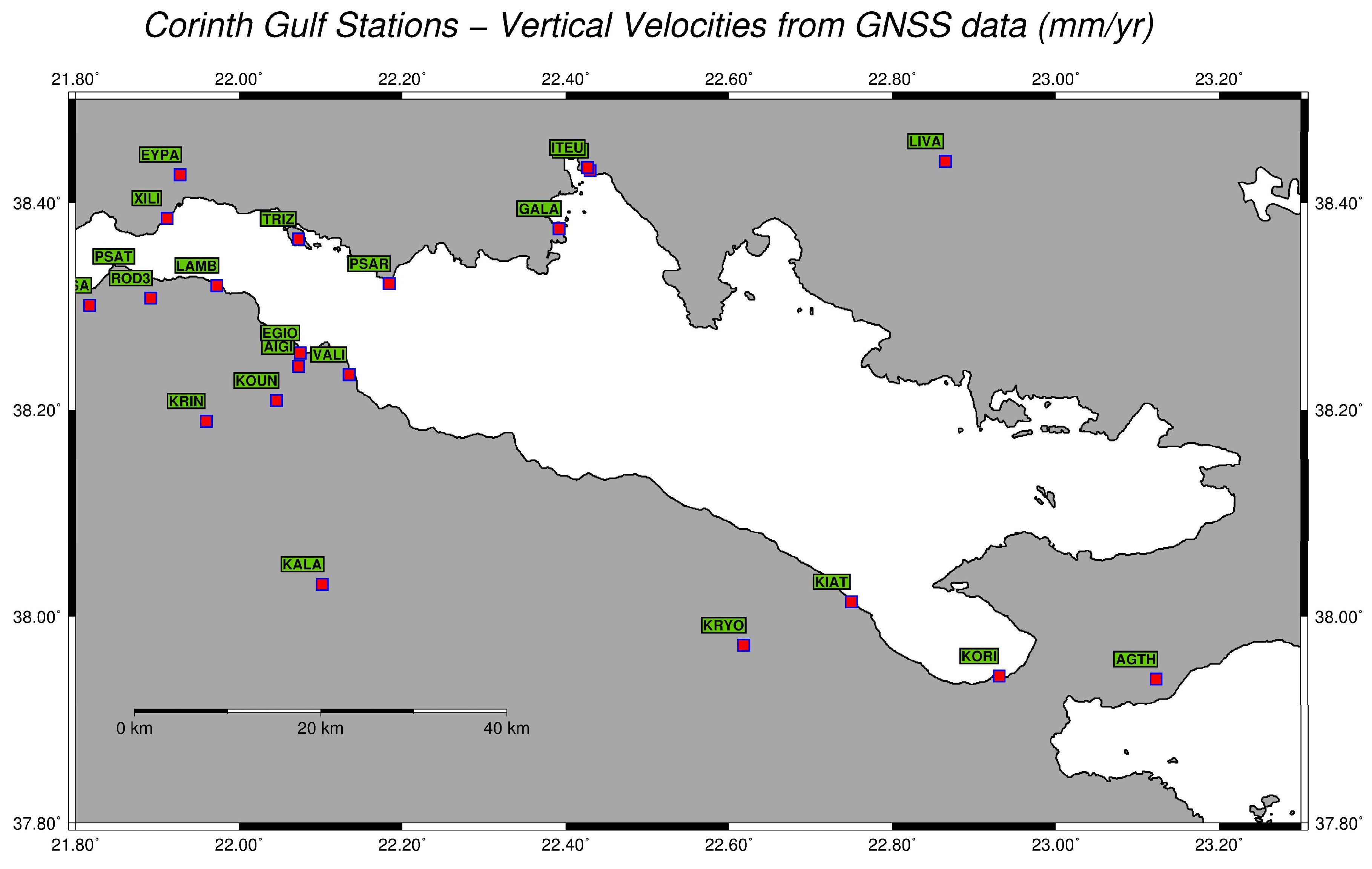
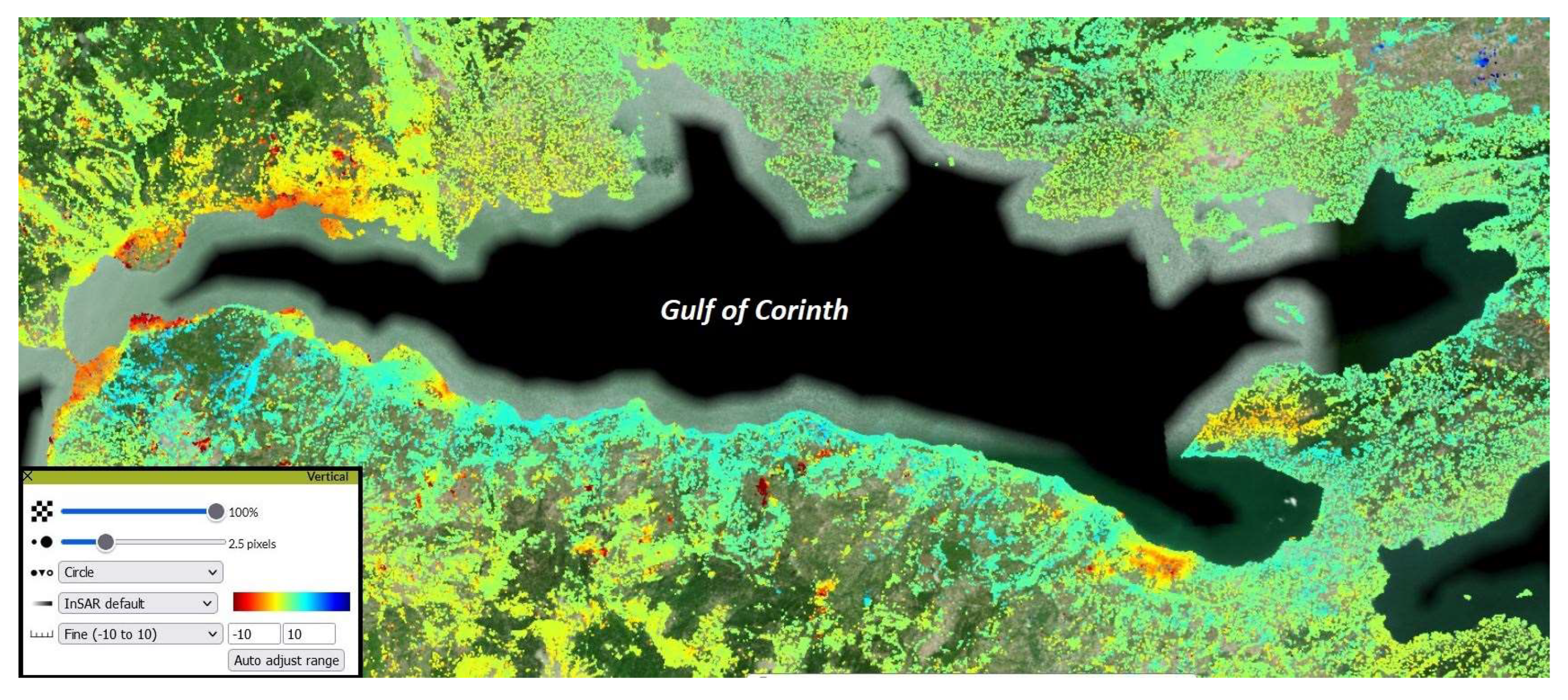
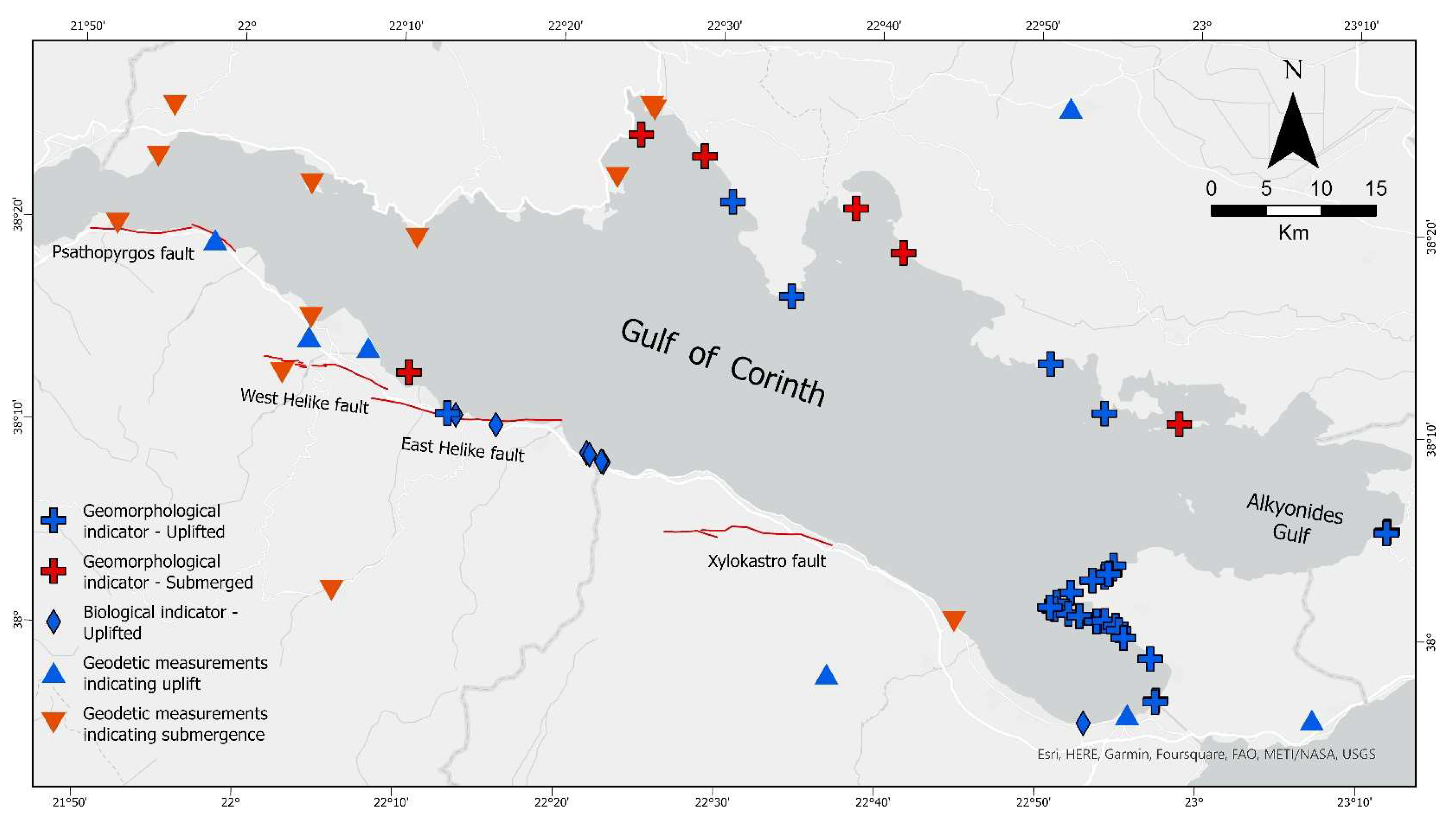
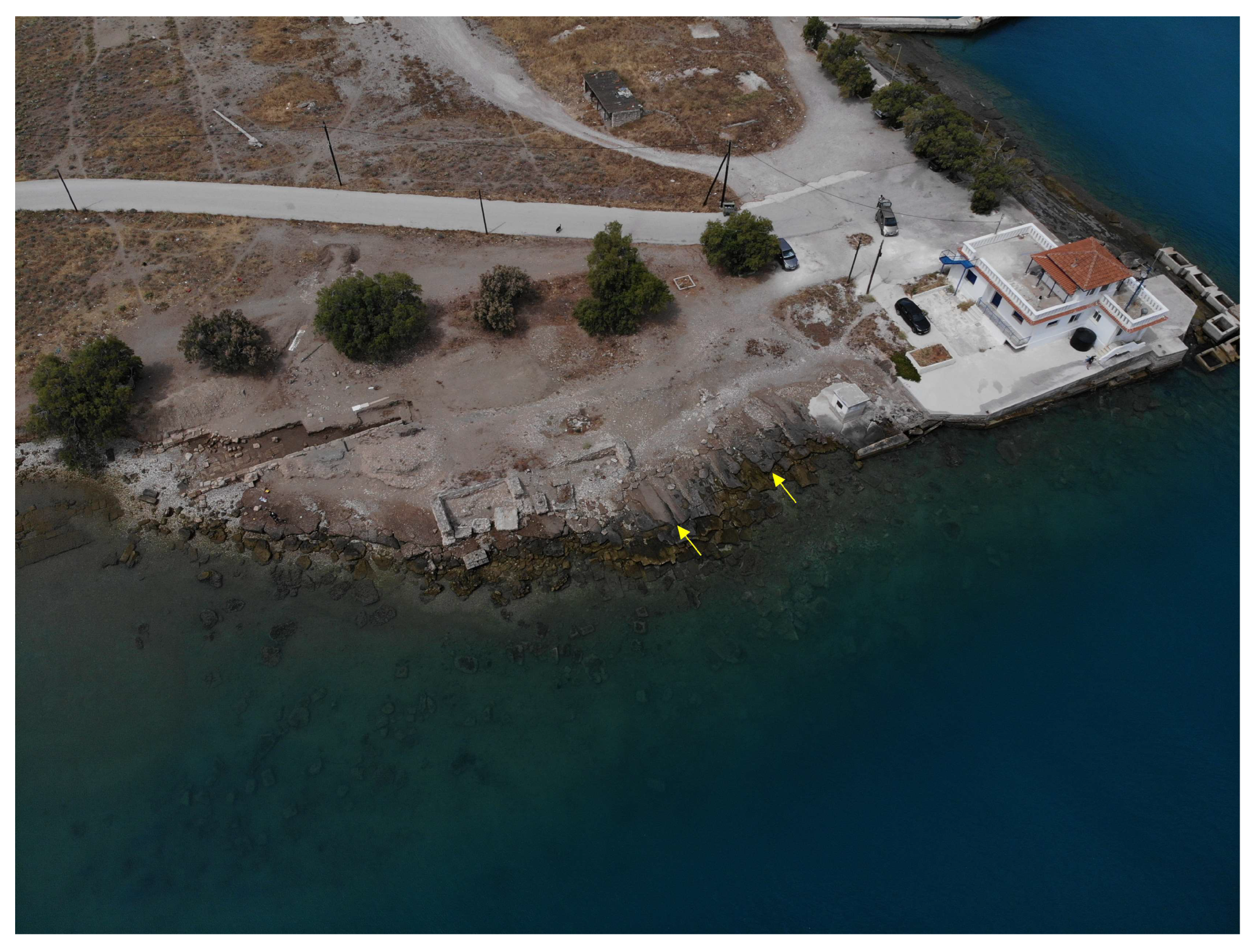
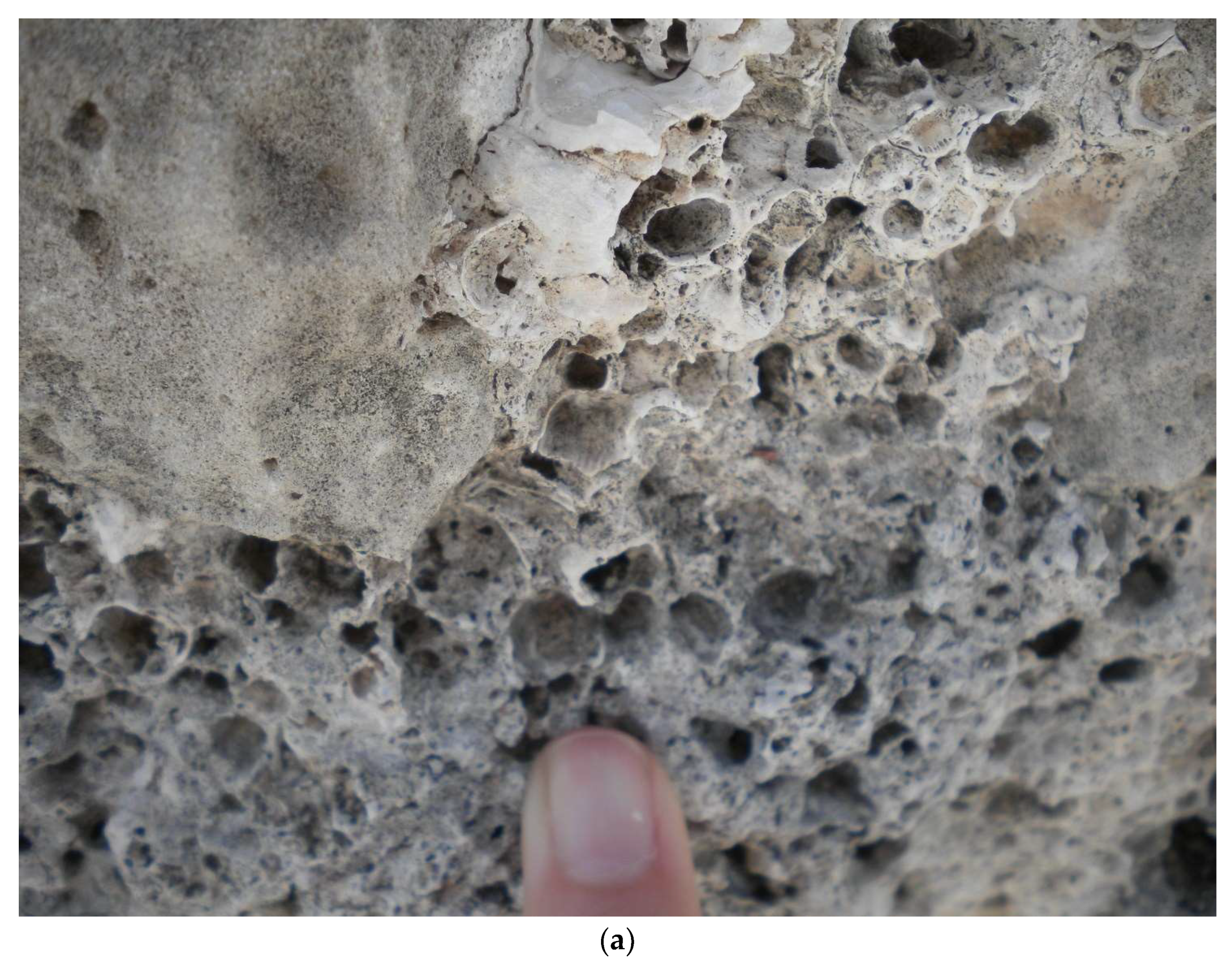
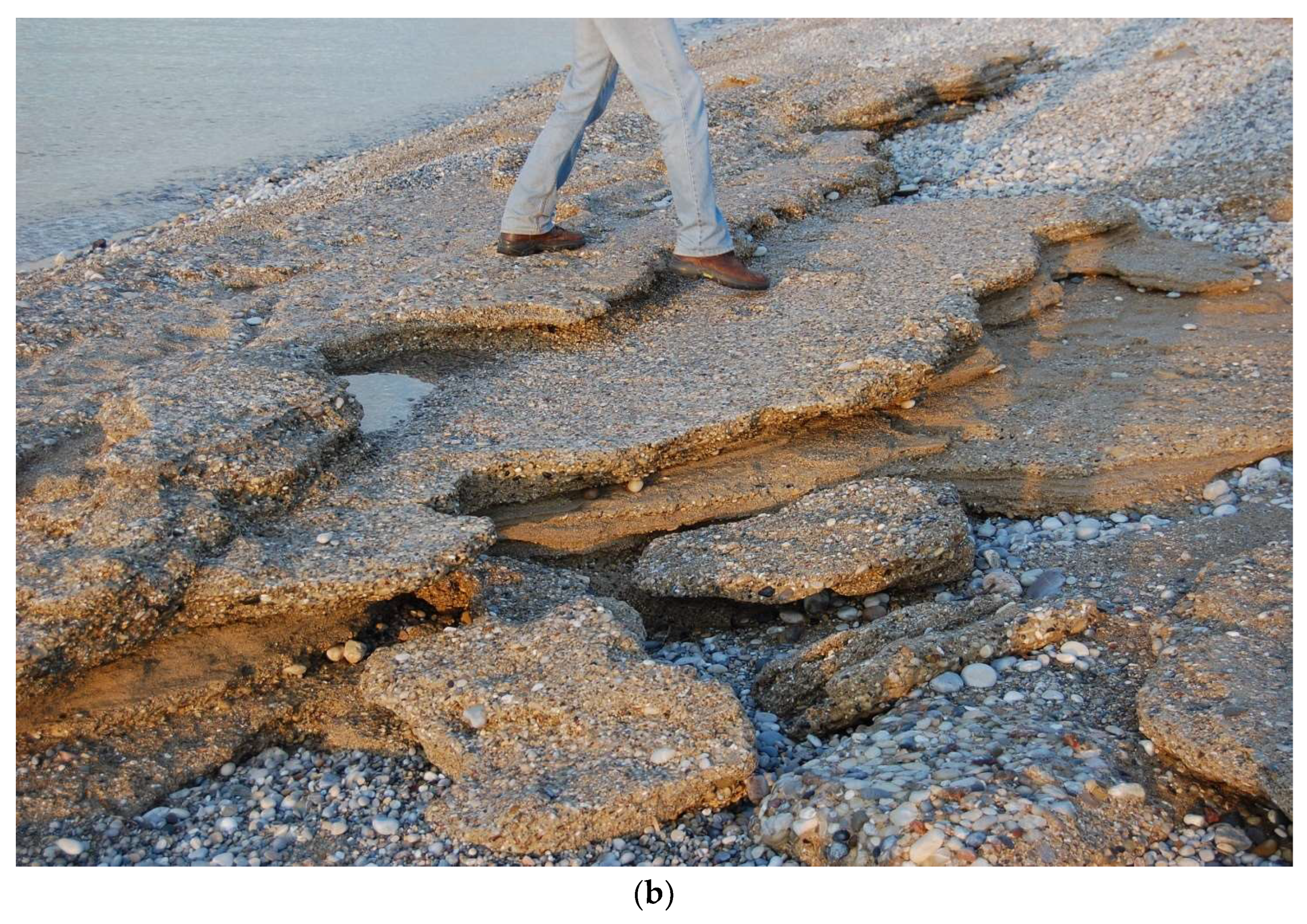
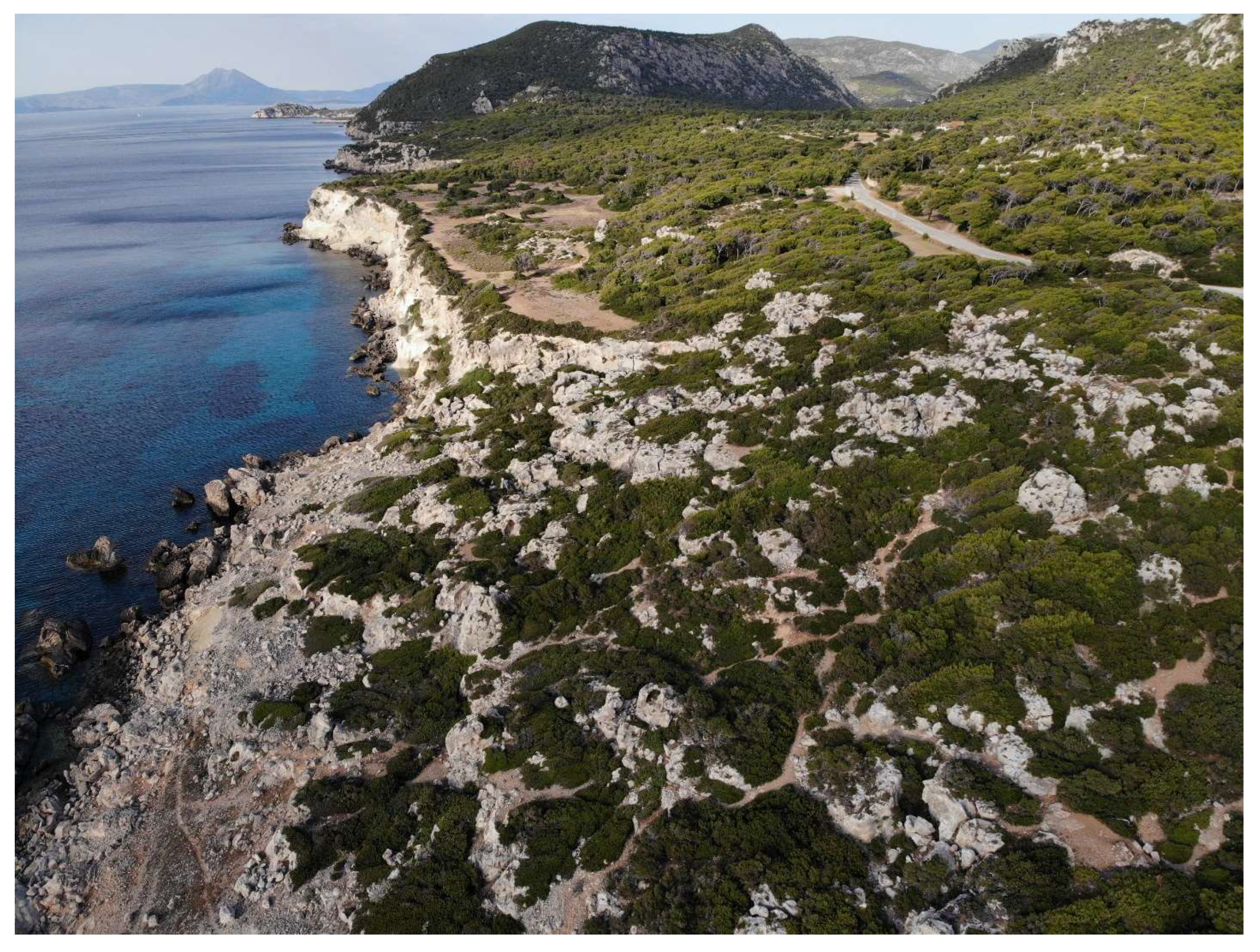

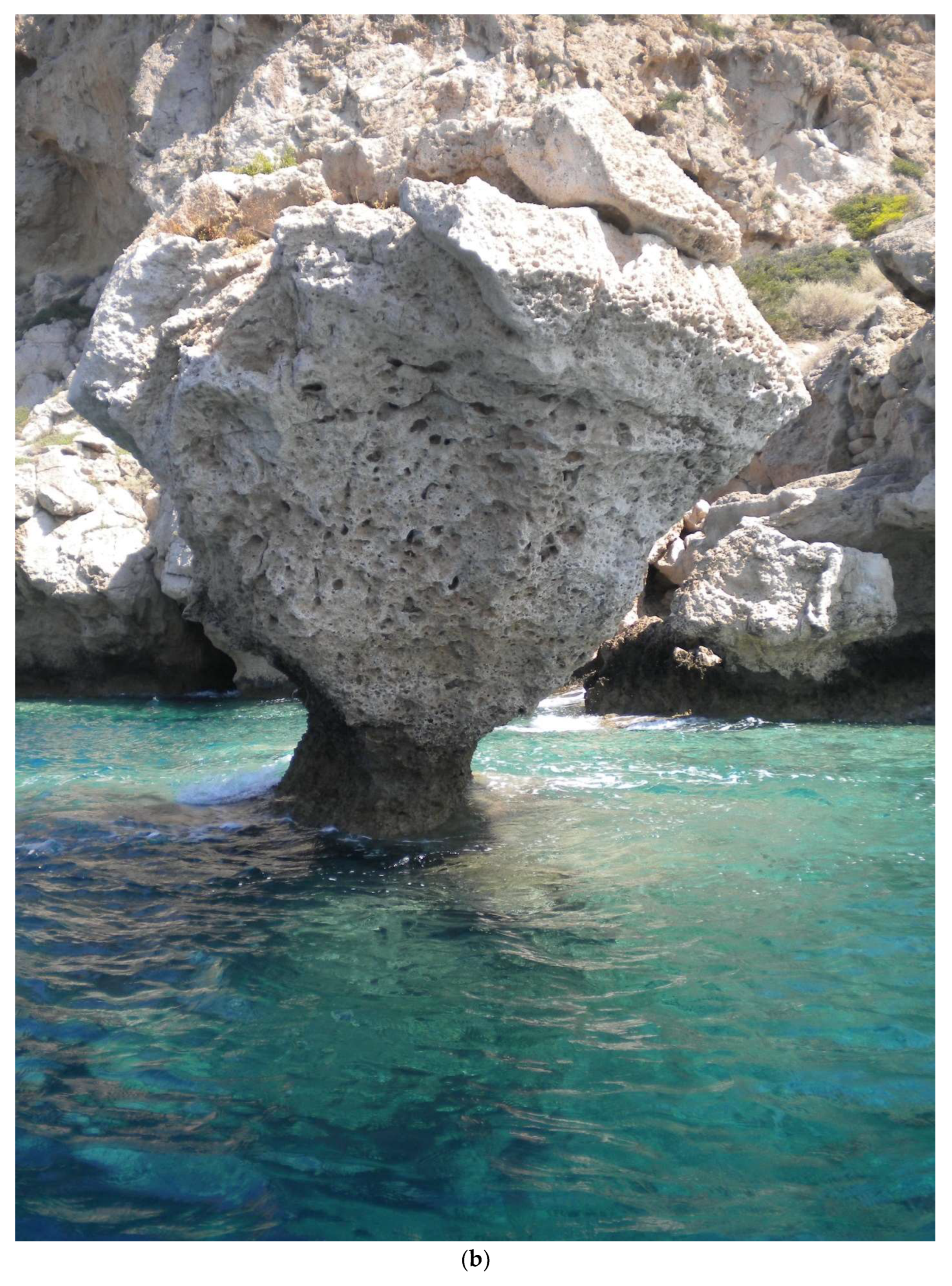
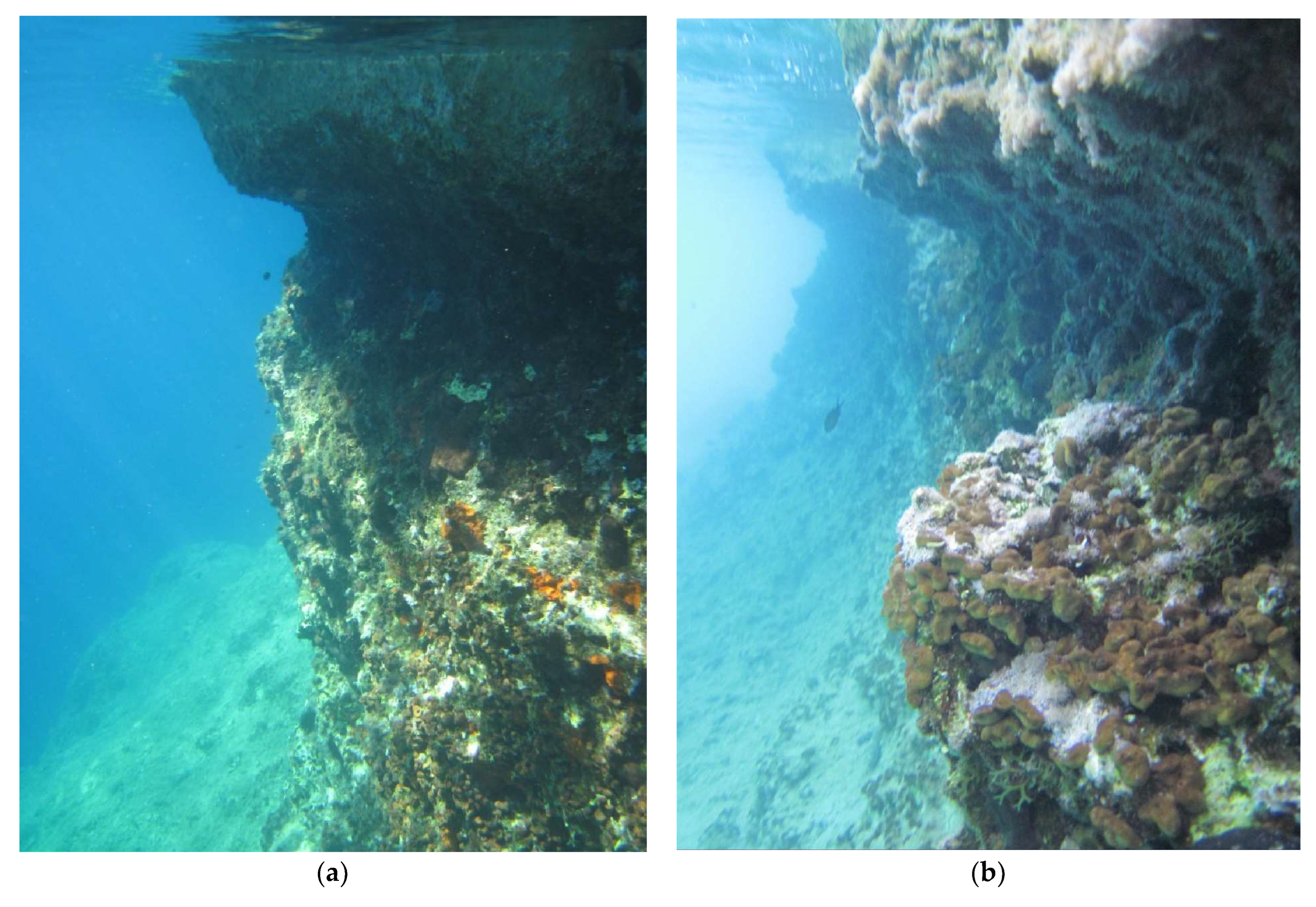


| Longitude (°) | Latitude (°) | Vup (mm/a) | Sd (mm/a) | Station Code |
|---|---|---|---|---|
| 23.123 | 37.939 | 0.2 | 2.1 | AGTH |
| 22.073 | 38.242 | 3.5 | 1.1 | AIGI |
| 23.440 | 37.734 | 1.4 | 0.9 | AIGU |
| 22.075 | 38.255 | −0.8 | 1.7 | EGIO |
| 21.928 | 38.427 | −1.4 | 0.6 | EYPA |
| 22.392 | 38.375 | −2.3 | 1.1 | GALA |
| 22.430 | 38.431 | −1.8 | 0.9 | ITEA |
| 22.427 | 38.434 | −1.3 | 1.1 | ITEU |
| 22.102 | 38.031 | −0.7 | 1.2 | KALA |
| 22.750 | 38.014 | −1.7 | 1.1 | KIAT |
| 22.931 | 37.942 | 0.5 | 0.6 | KORI |
| 22.046 | 38.209 | −1.0 | 0.7 | KOUN |
| 22.618 | 37.972 | 0.6 | 1.1 | KRYO |
| 21.973 | 38.320 | 1.7 | 1.0 | LAMB |
| 22.865 | 38.440 | 1.3 | 1.2 | LIVA |
| 22.184 | 38.322 | −0.8 | 0.7 | PSAR |
| 21.871 | 38.329 | −3.4 | 1.0 | PSAT |
| 22.073 | 38.365 | −2.1 | 0.6 | TRIZ |
| 22.135 | 38.234 | 2.3 | 0.9 | VALI |
| 21.912 | 38.385 | −6.2 | 1.0 | XILI |
Disclaimer/Publisher’s Note: The statements, opinions and data contained in all publications are solely those of the individual author(s) and contributor(s) and not of MDPI and/or the editor(s). MDPI and/or the editor(s) disclaim responsibility for any injury to people or property resulting from any ideas, methods, instructions or products referred to in the content. |
© 2023 by the authors. Licensee MDPI, Basel, Switzerland. This article is an open access article distributed under the terms and conditions of the Creative Commons Attribution (CC BY) license (https://creativecommons.org/licenses/by/4.0/).
Share and Cite
Evelpidou, N.; Ganas, A.; Karkani, A.; Spyrou, E.; Saitis, G. Late Quaternary Relative Sea-Level Changes and Vertical GNSS Motions in the Gulf of Corinth: The Asymmetric Localization of Deformation Inside an Active Half-Graben. Geosciences 2023, 13, 329. https://doi.org/10.3390/geosciences13110329
Evelpidou N, Ganas A, Karkani A, Spyrou E, Saitis G. Late Quaternary Relative Sea-Level Changes and Vertical GNSS Motions in the Gulf of Corinth: The Asymmetric Localization of Deformation Inside an Active Half-Graben. Geosciences. 2023; 13(11):329. https://doi.org/10.3390/geosciences13110329
Chicago/Turabian StyleEvelpidou, Niki, Athanassios Ganas, Anna Karkani, Evangelos Spyrou, and Giannis Saitis. 2023. "Late Quaternary Relative Sea-Level Changes and Vertical GNSS Motions in the Gulf of Corinth: The Asymmetric Localization of Deformation Inside an Active Half-Graben" Geosciences 13, no. 11: 329. https://doi.org/10.3390/geosciences13110329











